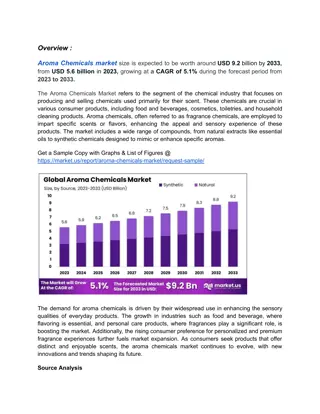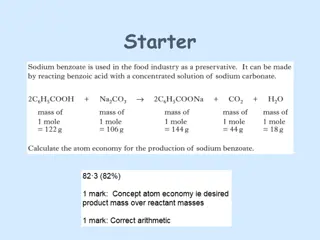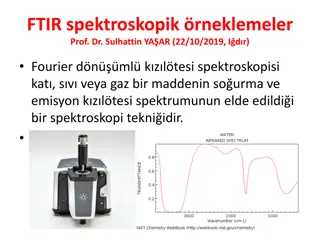Understanding Functional Groups in Organic Chemistry
Functional groups in organic chemistry are specific groups of atoms within molecules that determine the chemical properties of the compound. This content provides visual representations and descriptions of various functional groups such as alkanes, alkenes, alcohols, aldehydes, acids, and esters. Le
0 views • 38 slides
Understanding the Binding Role of Alcohols and Phenols in Drug Molecules
The role of alcohols and phenols in drug molecules is crucial as they are frequently involved in hydrogen bonding interactions. By creating analogues with modified functional groups, such as ethers and esters, the importance of specific groups can be determined. The presence or absence of hydrogen b
2 views • 20 slides
Overview of Lipids: Classification and Biological Importance
Lipids are organic substances that play a crucial role in biological systems. They include simple lipids, complex lipids like phospholipids and glycolipids, and derived lipids. Simple lipids are esters of fatty acids with various alcohols, while complex lipids are sub-classified based on the type of
2 views • 38 slides
Understanding Lipids: Waxes, Fats, and Fixed Oils
Lipids are organic compounds like waxes, fats, and fixed oils found in plants and animals. Fixed oils are reserve food materials, while fats are solid at higher temperatures. These substances are esters of glycerol and fatty acids, with various components giving them unique properties and flavors. C
0 views • 20 slides
Aroma Chemicals Market Expected to Soar with Surge in Organic and Natural Produc
Aroma Chemicals Market; By Source(Synthetic, Natural, Natural-Identical), By Products(Benzenoids, Terpenes and Terpenoids, Musk Chemicals, Others) (Ketones, Esters, Aldehydes), Application, Flavors, Convenience Foods, Confectionery, Dairy Products, B
0 views • 4 slides
Overview of Acyl Chlorides in Organic Chemistry
Acyl chlorides, also known as acid chlorides, are important compounds in organic chemistry. They can be prepared from carboxylic acids and thionyl chloride, and are reactive towards various nucleophiles leading to the formation of carboxylic acid esters, primary and secondary amides. Acyl chlorides
0 views • 5 slides
Baeyer-Villiger Oxidation: Mechanism and Migration Aptitude
The Baeyer-Villiger oxidation is a key organic reaction that transforms ketones into esters or cyclic ketones into lactones using peroxyacids. The mechanism involves protonation of the carbonyl group and migration of substituents. Migration aptitude in this reaction determines the regioselectivity,
0 views • 10 slides
Understanding Essential Oils: Properties, Chemistry, and Uses
Explore the fascinating world of essential oils, from their properties and uses to the chemistry behind their distinctive aromas. Learn about terpenes, key components in essential oils, and discover their modern applications in cosmetics, cleaning, flavors, and more. Understand what essential oils a
0 views • 36 slides
Understanding Esters and Their Formation in Chemistry
Learn about esters, their formation through esterification, naming conventions, and how to prepare esters using condensation reactions. Explore the distinct properties of esters, their role in fragrances, flavors, and industrial applications. Get insights into the experimental setup for preparing es
0 views • 17 slides
Understanding the Hand Wet Lay-Up Process in Composite Fabrication
Hand wet lay-up involves combining reinforcing fibers like E-glass, S-glass, Aramid, or Carbon/Graphite with resins such as polyesters, vinyl esters, or epoxies during part fabrication. The process includes preparing molds/tools, applying mold release agents, starting with a gel coat, cutting fabric
0 views • 23 slides
Smell Synthesis Lab: Creating Sweet-Smelling Esters
In this lab, students will use chemistry to synthesize esters with pleasant scents by combining different molecules. Safety precautions include wearing goggles, using a hot plate, and handling flammable and caustic chemicals carefully. The process involves controlled chemical reactions to create new
0 views • 9 slides
Fourier Transform Infrared (FTIR) Spectroscopy Examples by Prof. Dr. Sulhattin YAŞAR
Fourier Transform Infrared (FTIR) spectroscopy is a technique used to obtain the absorption and emission spectra of solid, liquid, or gas substances. This content provides characteristic absorption peaks for various functional groups, such as alkane, alkyl, alkenyl, alkynyl, aromatic compounds, alco
0 views • 15 slides
Understanding Cosmetic Creams: Types and Formulations
Cosmetic creams come in various types such as cold cream, emollient cream, and beeswax-borax cream, each serving different purposes for skincare. These creams are formulated as white emulsions with specific ingredients like cetyl esters wax, white wax, and mineral oils. Cold creams provide nourishme
0 views • 22 slides
Chemistry of Soaps and Detergents Evolution and Formation
Soaps and detergents play a vital role in human comfort, cleanliness, and industrial applications. This article delves into the chemistry involved in the formation of soaps, highlighting the compounds and processes. It explores the differences between soaps and detergents, detailing their origins an
0 views • 38 slides
Understanding Soap Making and Uses of Sodium Hydroxide
Soap, an ancient detergent made from fatty acids and alkalis like sodium hydroxide, has been utilized for over 3000 years. Fats and oils are essential raw materials for soap production, and organic acids play a role in creating esters. Sodium hydroxide, a key component in soap making, showcases its
0 views • 9 slides
Comprehensive Overview of Esterification Reactions
Esterification is a versatile chemical process to synthesize esters, involving various methods like Fischer esterification, Schotten-Baumann reaction, and Steglich esterification. Different reagents and catalysts are utilized for efficient ester formation, with considerations like reaction equilibri
0 views • 10 slides
Polyglycerol Esters of Fatty Acids: Key to Enhanced Product Stability
Polyglycerol esters of fatty acids (PGE) are versatile, natural emulsifiers used widely in food, cosmetics, and pharmaceuticals. At Spell Organics, we harness Polyglycerol Esters of Fatty Acids to elevate product stability, consistency, and shelf lif
0 views • 11 slides
Food Emulsifiers Market
Food Emulsifiers Market Size, Share, Forecast, & Trends Analysis by Type (Mono, Di-glycerides & Derivatives, Stearoyl Lactylates, Sorbitan Esters), Source (Animal, Plant), Application (Bakery Products, Dairy Products, Beverages) - Global Forecast to
0 views • 2 slides
Exploring the World of Esterification: Aromatic Fragrances to Pharmaceutical Applications
Esterification is a versatile chemical process that yields compounds with pleasant odors and diverse applications, from fragrances like banana and peppermint to pharmaceuticals like local anesthetics. The process involves reactions such as Fischer Esterification and Schotten-Baumann Esterification,
0 views • 21 slides
Polyglycerol Esters of Fatty Acids: Enhancing Quality Across Food Products
Polyglycerol Esters of Fatty Acids (PGE) are essential in improving the quality and consistency of various food products. These multifunctional emulsifiers enhance texture, stabilize emulsions, and prolong shelf life, making them vital for bakery, co
0 views • 4 slides



















